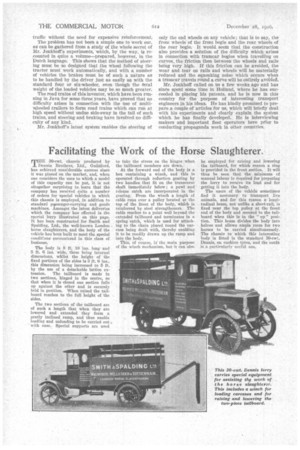Distributing the Load Over Many. Wheels.
Page 55

Page 56

If you've noticed an error in this article please click here to report it so we can fix it.
IT will be remembered that in an issuo of The, Commercial Motor published three years ago we dealt very fully with the system introduced by Mr. Henri W. Jonkhoff, of Semarang, Java, of coupling together 'a number of vehicles in train formation so as to carry large numbers of labourers and also to convey the products of Java, some of which, such as kapok and quinine, occupy a large loading space but are of light weight.
The roads in Java are serpentine in their character, and it was necessary, where vehicles were given a
train formation, to ensure that all the wheels of the train followed the course taken by the driving wheels of the tractor and did not cut in at corners.
Mr. Jonkhoff developed a number of schemes, in the earlier ones of which all the wheels of the trailers were steered by the pull given on a cable when the front wheels of the tractor deflected from a straight line. Mr. Jonkhoff has now, as a result of a long series of experiffents, reduced the system to its simplest proportions, still keeping to the bogie system which has formed the basis of his research from the very start, and he contends that only by increasing the number of axles is it possible with increased loads to ensure that the wheel pressure on the road is not increased ; in fact, his aim all through has been to reduce the vertical pressure per sq. in. of road surface exerted by any vehicle with its full load.
The outcome of his experiments has been to produce a tractor vehicle, the trailer portion of which is mounted on a turntable over the rear driving axle of the tractor, whilst the rear of the trailer is supported on a fourwheeled bogie, the whole of which is placed below the trailer, which is mounted upon another turntable. All coupled vehicles are mounted on two four-wheeled bogies. It is contended by Mr. Jonkhoff (and, of course, with justification, having been part of the argument which we have ourselves advanced for many years) that with multi-wheeled vehicles the upkeep of roads will be considerably reduced and roads of the present-day strength will be able to deal with normal
traffic without the need for expensive reinforcement.
The problem has not been a simple one to work out. as can be gathered from a study of the whole secret of Mr. Jonkhoff's experiments, which, by the way, is recounted in quite a volume—prepared, however, in the Dutch language. This shows that the method of steering must be so designed that the wheel following the tractor must work automatically, and with a number of vehicles the brakes must be of such a nature as to be handled by the driver just as easily as with the standard four or 61x-whee1er, even though the total weight of the loaded vehicles may be so much greater.
The road trains of this inventor, which have been running in Java for some three years, have proved that no difficulty arises in connection with the use of multiwheeled trailers to form road trains which can run at high speed without undue side-sway in the tail of such trains, and steering and braking have involved DO difficulty of any kind.
Mr. Jonkhoff's latest system enables the steering of only the end wheels on any vehicle; that is to say, the front wheels of the front bogie and the rear wheels of the rear bogie. It woul& seem that the construction also provides a solution of the difficulty which arises In connection with tramcar bogies when travelling on curves, the friction then between the wheels and rails being very high. If this friction can be avoided, the wear and tear on rails and wheels will be materially reduced and the squeaking noise which occurs when a tramcar travels round a curve will be entirely avoided.
Mr. Jonkhoff called on us a few weeks ago and has since spent some time in Holland, where he has succeeded in placing his patents, and he is now in this country for the purpose of interesting transport engineers in his ideas. He has kindly promised to prepare a couple of articles for us, which will briefly deal with his experiments and clearly explain the system which he has finally developed. He is interviewing makers and important fleet operators here prior to conducting propaganda work in other countries.




































































































